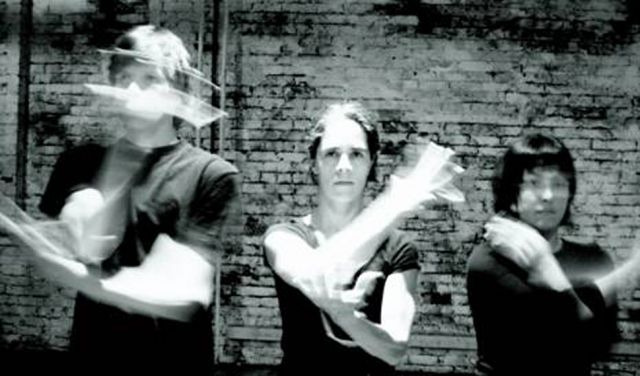Reading the Multiverse
Lightsey Darst gives a playful but close reading of the recent dance performances by Chris Yon ("The Infinite Multiverse") and Johanna Meyer and Judy Bauerlein ("Stroll").


THE OTHER DAY I WAS BEMOANING my pathetic summer reading to a friend, when it dawned on me that the dances I’ve seen make up another entire reading list. We generally rate reading more highly than viewing, but when you think about it, watching a dance requires many of the same imaginative feats as reading a book: suspending disbelief, expanding from a part to a whole, drawing connections among disparate elements, remaining sympathetic and open to the unexpected, etc. In fact, dance poses a bit more of an attentive challenge, in that one must be constantly present, steadfast in one’s refusal to replace the dance with the thought of the dance.
So: what have I read lately? The Southern Theater‘s summer dance season, finishing off with Johanna Meyer and Judy Bauerlein’s Stroll and Chris Yon’s The Infinite Multiverse.
Meyer and Bauerlein deluge the reader/viewer with character-driven snippets, most so short that they barely rise to the visible level before they’re interrupted by another, most arranged along the axis of female identity, and all framed in a laboratory setting. A self-fanning Marilyn Monroe, a ’40s pose-off queen, complete with dangling ciggy, some suggestive ciggy-stealing, portentous walking, a tiger mask, a faux-kabuki death scene (loud death rattles utterly ignored by the other performer) — cut in with a lot of fiddly adjustment of props and a mysterious antagonism between the two characters.
I remember I couldn’t make head or tails of the press release for this show, and now I can see why. I don’t get why the lab setting is necessary, given that we can accept the theater itself (like the book) as a space for exploration, but Meyer and Bauerlein make the setting explicit with white coats, secret codes, and dial twiddling (and please, can we consider Stroll to have capped the dial-twiddling fad that’s dogged dance lately?). I think I caught a voiceover reading a snippet of Frankenstein, so, taken together with the tiger mask, I could posit some theme of interspecies mixing… as in “Third-wave feminism, attempting to claim distinctly unfeminist idols for the cause (Marilyn Monroe, Betty Page, etc), creates an unsustainable hybrid” blah blah blah. Sontag was right about this kind of criticism: decoding a work destroys it, substituting theory for unstable or unsatisfactory flesh.
Chris Yon avoids foundering in a flotsam of about-ness by skirting subject matter altogether. His The Infinite Multiverse earns its grand title by deploying its four dancers (Yon, Taryn Griggs, Justin Jones, and Kristin Van Loon) in a series of structures (symmetries, asymmetries, unison, scatter, cause-and-effect, isolation) that might underlie everything — love affairs, world history, ice formation, planetary motion, family dynamics, atoms swirling around a nucleus. Despite the almost total lack of eye contact, galvanic lines run between the dancers so that each change (and the dance is constantly shifting) tickles your structural spidey senses, which is (in case you can’t tell) a surprising and fun experience, like listening to music through an ear you didn’t know you had.
______________________________________________________
What I love about The Infinite Multiverse is the pleasure it takes in the flesh of dance… Just when you think his exhaustive exploration of what six pointing hands can do will drive you mad, he cuts away to twists and charged radial space, like living fractals, or flowers.
______________________________________________________
Part of what I love about The Infinite Multiverse is the pleasure it takes in the flesh of dance. If Yon has a basic mode of staccato Rube Goldberg-esque gesture sequences, rarely changing level, he can still think outside that mode, as in the processional hops that begin The Infinite Multiverse, or a sensuous swan-like unfolding that sends Van Loon to the floor. Within his mode, too, he and his dancers find variety, shifting on a dime from automaton to human, execution to revelation. Just when you think his exhaustive exploration of what six pointing hands can do will drive you mad (the middle section does sag a bit), he cuts away to twists and charged radial space, like living fractals, or flowers.
Yon’s multiverse has a strange repeating tendency towards an old-fashioned, front-facing, foot-tapping jazz phrase, which reminds me of the recurrent metaphysical question about whether we live in a fundamentally elegant universe — and it reminds me of a slew of other things, too, not least the dancing figure that signifies The World in tarot. This phrase is not super-elegant, though, but a little moth-eaten, as if — well, suffice it to say that my restless reading brain ran a little amuck here, happily connecting and decoding. But just then, Yon punctuated the multiplying meanings with a perfect surprise of an ending. The Infinite Multiverse, like a good book, invites and rewards reading, but refuses to give itself up entirely to reason; it remains alive.
______________________________________________________
Noted performance details:
Johanna Meyer and Judy Bauerlein’s Stroll and Chris Yon’s The Infinite Multiverse was on stage at the Southern Theater in Minneapolis July 22-24.
______________________________________________________
About the author: Originally from Tallahassee, Lightsey Darst is a poet, dance writer, and adjunct instructor at various Twin Cities colleges. Her manuscript Find the Girl has just been published by Coffee House; she has also been awarded a 2007 NEA Fellowship. She hosts the writing salon, “The Works.”